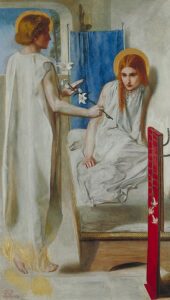 When I find myself in times of trouble,
When I find myself in times of trouble,
Mother Mary comes to me
Speaking words of wisdom, let it be
And in my hour of darkness
she is standing right in front of me
Speaking words of wisdom, let it be[1]
I did not begin this morning with “Happy Christmas” or “Merry Christmas” because, although it’s December 24th, it’s not Christmas; it’s not even Christmas Eve yet! The rest of the world may want you to think it’s Christmas and that it has been since mid-October, but the Episcopal Church insists that it is not yet Christmas. In fact, there’s still more than nine months until Christmas if we believe the good news we just heard from the evangelist Luke! We still have some time to wait for trees and carols and packages, for festive dinners and “chestnuts roasting on an open fire” and the “holy infant so tender and mild.” We still have some of the Advent season to complete and so on this, the Fourth Sunday of Advent, we focus our attention on Mary and consider not the end of her pregnancy, but its beginning, that moment when the Angel Gabriel told her that she had been chosen to be the mother of the Messiah.
Visual artists depict the stories of the bible in many fascinating ways and their works can help us explore scripture’s meaning. Often their images capture or suggest nuances in a story that we might miss just hearing the words. This morning, I’d like to tell you about three paintings that particularly speak to me about the Annunciation. They are the Pre-Raphaelite Dante Gabriel Rosetti’s Ecce Ancilla Domini painted in the 1850s, Florentine painter Sandro Botticelli’s late 15th Century Cestello Annunciation, and a contemporary piece by American artist John Collier.


